Business Communication and Information Principles Assignment Analysis
VerifiedAdded on 2020/06/06
|16
|3732
|102
Homework Assignment
AI Summary
This assignment solution covers key principles of business communication and information management. It includes detailed sections on delivering presentations, handling mail efficiently, storing and retrieving information securely, maintaining and issuing stationery and supplies, utilizing word processing software, and resolving customer complaints effectively. The document explores advantages and limitations of various communication methods, audience considerations, contingency planning, voice projection techniques, and question-and-answer strategies for presentations. It also addresses junk mail, mail handling procedures, franking machine operation, package preparation, and reporting suspicious items. Furthermore, it delves into information storage systems, security requirements, filing techniques, and search strategies. The assignment also covers organizational policies for stationery management, stock checks, supplier considerations, and waste disposal methods. It also discusses word processing software features, document formatting, and quality assurance. Finally, it explores customer complaint resolution techniques, conflict management, organizational procedures, and escalation protocols. This comprehensive assignment provides a thorough overview of essential business communication and information management practices.
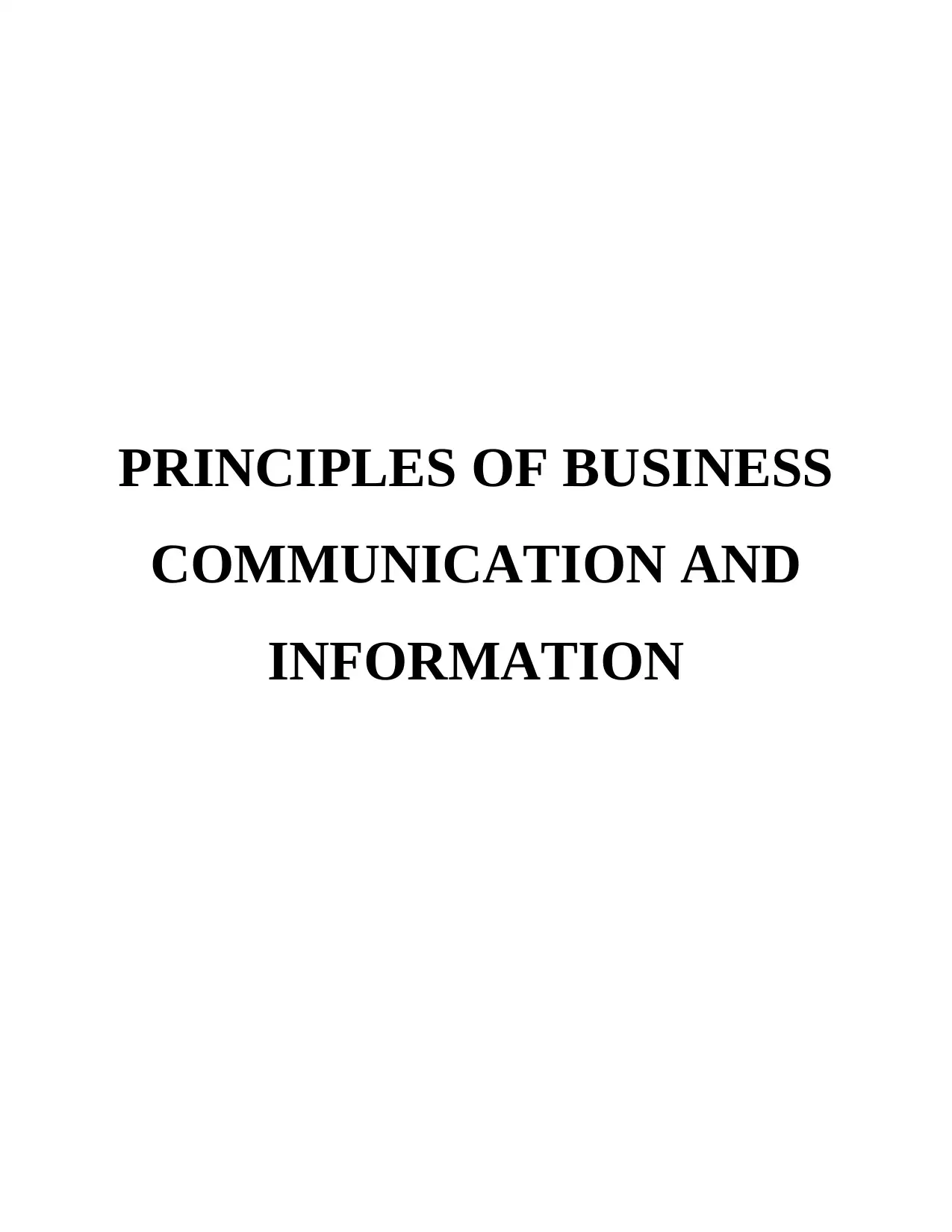
PRINCIPLES OF BUSINESS
COMMUNICATION AND
INFORMATION
COMMUNICATION AND
INFORMATION
Paraphrase This Document
Need a fresh take? Get an instant paraphrase of this document with our AI Paraphraser
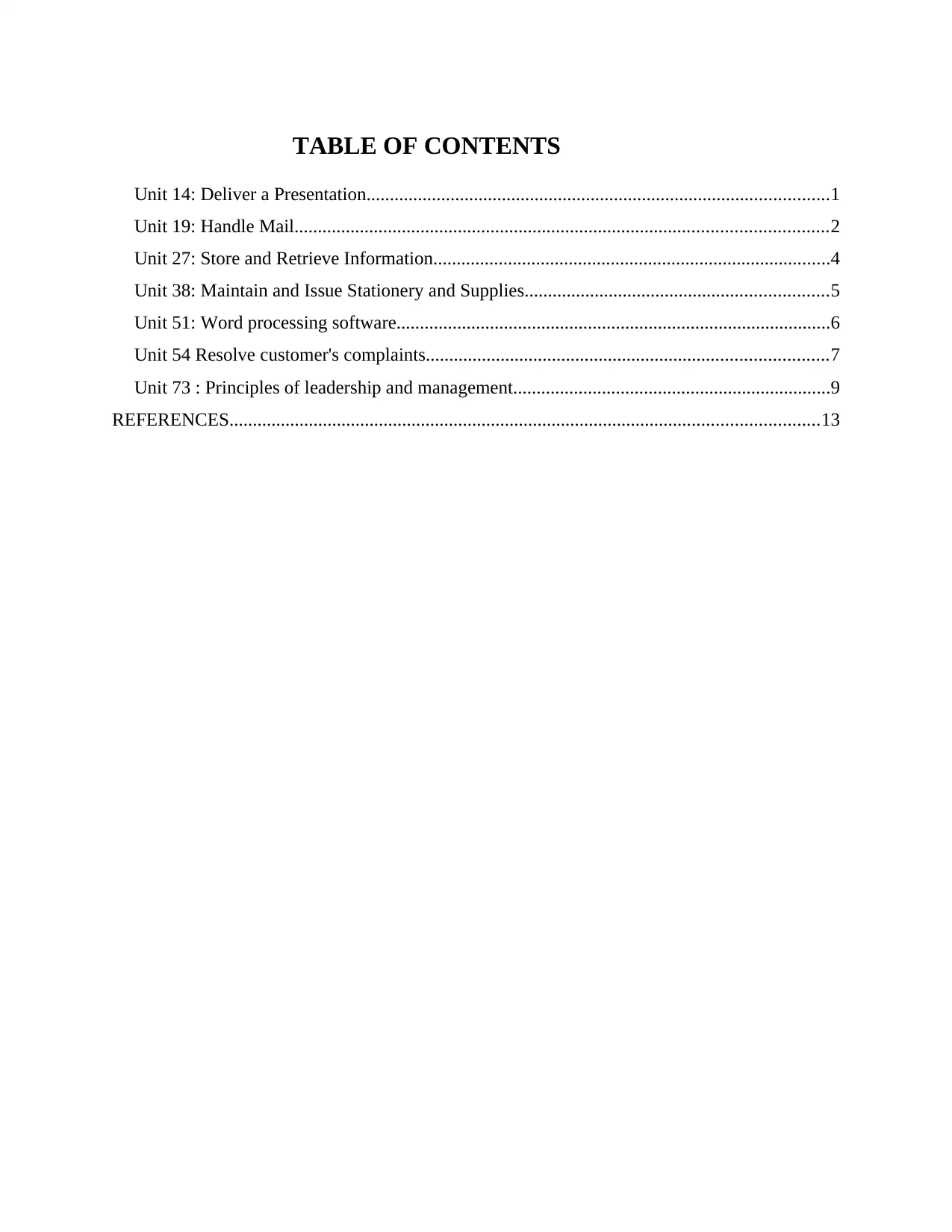
TABLE OF CONTENTS
Unit 14: Deliver a Presentation...................................................................................................1
Unit 19: Handle Mail..................................................................................................................2
Unit 27: Store and Retrieve Information.....................................................................................4
Unit 38: Maintain and Issue Stationery and Supplies.................................................................5
Unit 51: Word processing software.............................................................................................6
Unit 54 Resolve customer's complaints......................................................................................7
Unit 73 : Principles of leadership and management....................................................................9
REFERENCES..............................................................................................................................13
Unit 14: Deliver a Presentation...................................................................................................1
Unit 19: Handle Mail..................................................................................................................2
Unit 27: Store and Retrieve Information.....................................................................................4
Unit 38: Maintain and Issue Stationery and Supplies.................................................................5
Unit 51: Word processing software.............................................................................................6
Unit 54 Resolve customer's complaints......................................................................................7
Unit 73 : Principles of leadership and management....................................................................9
REFERENCES..............................................................................................................................13
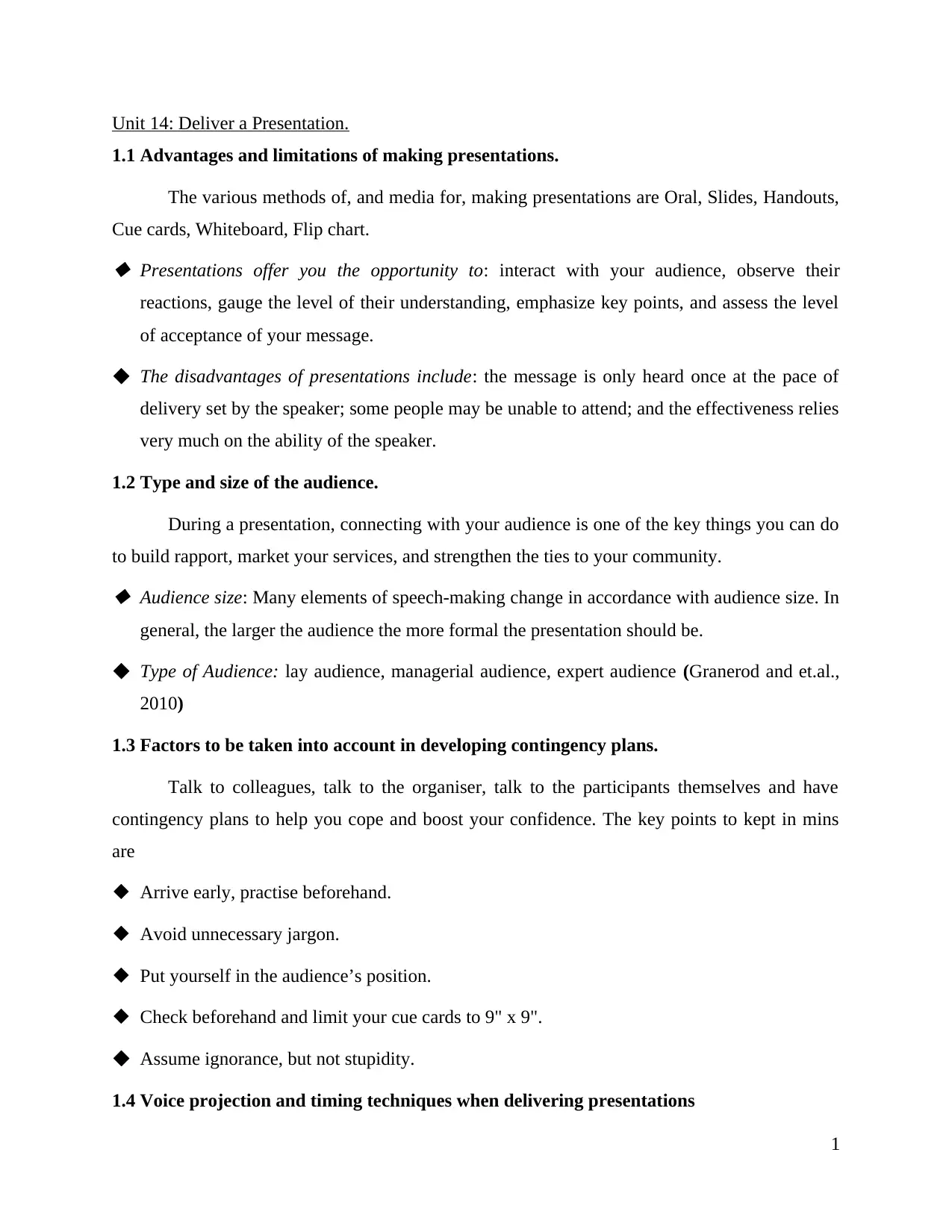
Unit 14: Deliver a Presentation.
1.1 Advantages and limitations of making presentations.
The various methods of, and media for, making presentations are Oral, Slides, Handouts,
Cue cards, Whiteboard, Flip chart.
Presentations offer you the opportunity to: interact with your audience, observe their
reactions, gauge the level of their understanding, emphasize key points, and assess the level
of acceptance of your message.
The disadvantages of presentations include: the message is only heard once at the pace of
delivery set by the speaker; some people may be unable to attend; and the effectiveness relies
very much on the ability of the speaker.
1.2 Type and size of the audience.
During a presentation, connecting with your audience is one of the key things you can do
to build rapport, market your services, and strengthen the ties to your community.
Audience size: Many elements of speech-making change in accordance with audience size. In
general, the larger the audience the more formal the presentation should be.
Type of Audience: lay audience, managerial audience, expert audience (Granerod and et.al.,
2010)
1.3 Factors to be taken into account in developing contingency plans.
Talk to colleagues, talk to the organiser, talk to the participants themselves and have
contingency plans to help you cope and boost your confidence. The key points to kept in mins
are
Arrive early, practise beforehand.
Avoid unnecessary jargon.
Put yourself in the audience’s position.
Check beforehand and limit your cue cards to 9" x 9".
Assume ignorance, but not stupidity.
1.4 Voice projection and timing techniques when delivering presentations
1
1.1 Advantages and limitations of making presentations.
The various methods of, and media for, making presentations are Oral, Slides, Handouts,
Cue cards, Whiteboard, Flip chart.
Presentations offer you the opportunity to: interact with your audience, observe their
reactions, gauge the level of their understanding, emphasize key points, and assess the level
of acceptance of your message.
The disadvantages of presentations include: the message is only heard once at the pace of
delivery set by the speaker; some people may be unable to attend; and the effectiveness relies
very much on the ability of the speaker.
1.2 Type and size of the audience.
During a presentation, connecting with your audience is one of the key things you can do
to build rapport, market your services, and strengthen the ties to your community.
Audience size: Many elements of speech-making change in accordance with audience size. In
general, the larger the audience the more formal the presentation should be.
Type of Audience: lay audience, managerial audience, expert audience (Granerod and et.al.,
2010)
1.3 Factors to be taken into account in developing contingency plans.
Talk to colleagues, talk to the organiser, talk to the participants themselves and have
contingency plans to help you cope and boost your confidence. The key points to kept in mins
are
Arrive early, practise beforehand.
Avoid unnecessary jargon.
Put yourself in the audience’s position.
Check beforehand and limit your cue cards to 9" x 9".
Assume ignorance, but not stupidity.
1.4 Voice projection and timing techniques when delivering presentations
1
⊘ This is a preview!⊘
Do you want full access?
Subscribe today to unlock all pages.

Trusted by 1+ million students worldwide
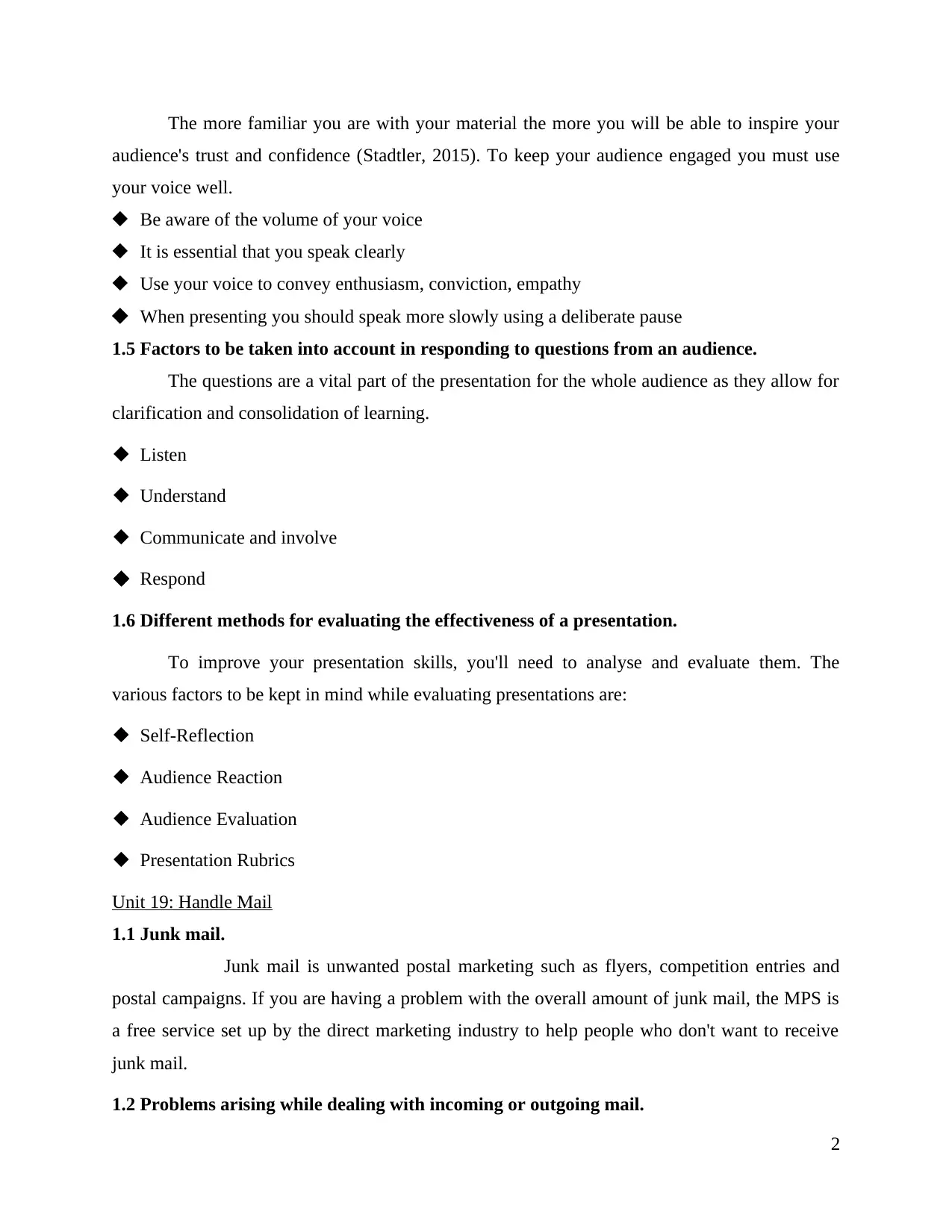
The more familiar you are with your material the more you will be able to inspire your
audience's trust and confidence (Stadtler, 2015). To keep your audience engaged you must use
your voice well.
Be aware of the volume of your voice
It is essential that you speak clearly
Use your voice to convey enthusiasm, conviction, empathy
When presenting you should speak more slowly using a deliberate pause
1.5 Factors to be taken into account in responding to questions from an audience.
The questions are a vital part of the presentation for the whole audience as they allow for
clarification and consolidation of learning.
Listen
Understand
Communicate and involve
Respond
1.6 Different methods for evaluating the effectiveness of a presentation.
To improve your presentation skills, you'll need to analyse and evaluate them. The
various factors to be kept in mind while evaluating presentations are:
Self-Reflection
Audience Reaction
Audience Evaluation
Presentation Rubrics
Unit 19: Handle Mail
1.1 Junk mail.
Junk mail is unwanted postal marketing such as flyers, competition entries and
postal campaigns. If you are having a problem with the overall amount of junk mail, the MPS is
a free service set up by the direct marketing industry to help people who don't want to receive
junk mail.
1.2 Problems arising while dealing with incoming or outgoing mail.
2
audience's trust and confidence (Stadtler, 2015). To keep your audience engaged you must use
your voice well.
Be aware of the volume of your voice
It is essential that you speak clearly
Use your voice to convey enthusiasm, conviction, empathy
When presenting you should speak more slowly using a deliberate pause
1.5 Factors to be taken into account in responding to questions from an audience.
The questions are a vital part of the presentation for the whole audience as they allow for
clarification and consolidation of learning.
Listen
Understand
Communicate and involve
Respond
1.6 Different methods for evaluating the effectiveness of a presentation.
To improve your presentation skills, you'll need to analyse and evaluate them. The
various factors to be kept in mind while evaluating presentations are:
Self-Reflection
Audience Reaction
Audience Evaluation
Presentation Rubrics
Unit 19: Handle Mail
1.1 Junk mail.
Junk mail is unwanted postal marketing such as flyers, competition entries and
postal campaigns. If you are having a problem with the overall amount of junk mail, the MPS is
a free service set up by the direct marketing industry to help people who don't want to receive
junk mail.
1.2 Problems arising while dealing with incoming or outgoing mail.
2
Paraphrase This Document
Need a fresh take? Get an instant paraphrase of this document with our AI Paraphraser
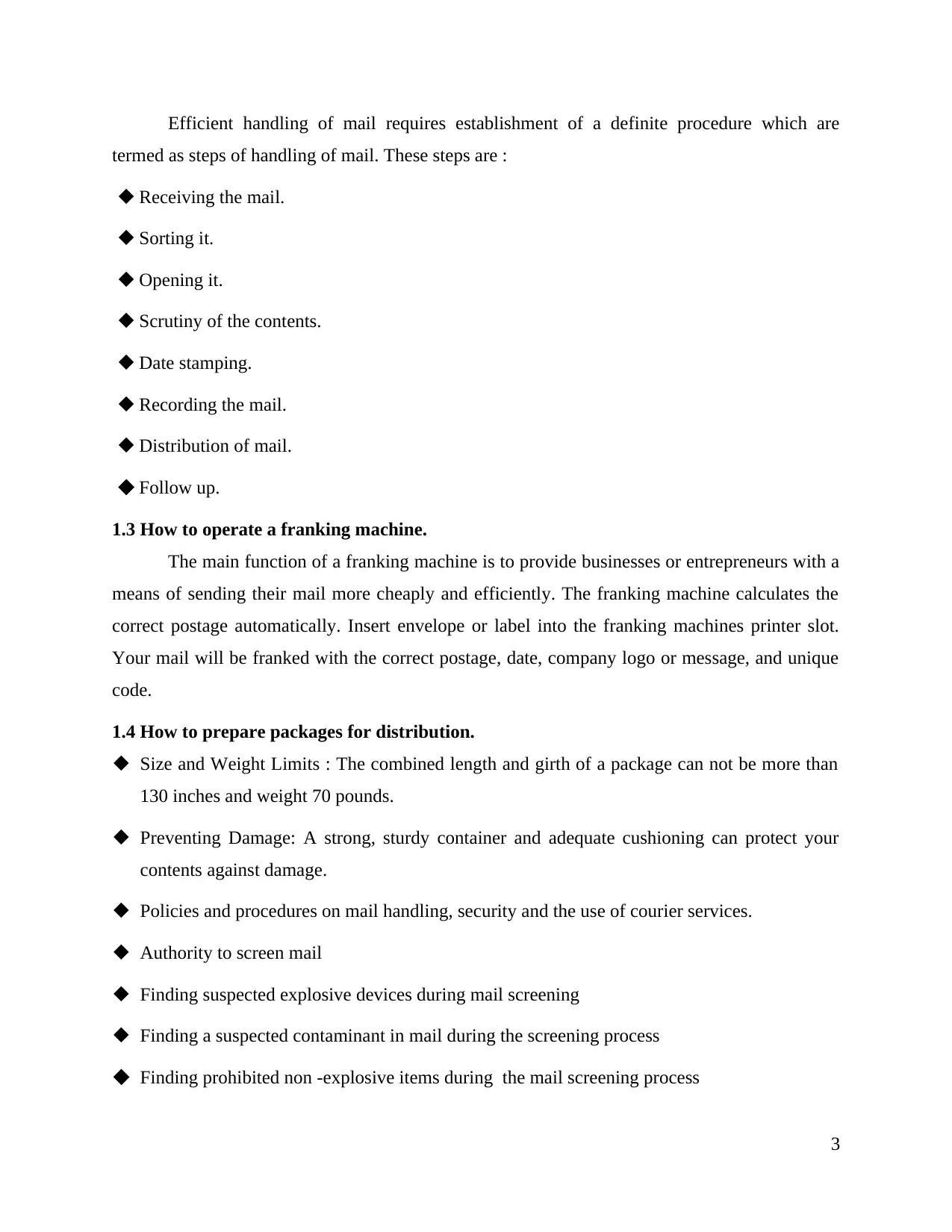
Efficient handling of mail requires establishment of a definite procedure which are
termed as steps of handling of mail. These steps are :
Receiving the mail.
Sorting it.
Opening it.
Scrutiny of the contents.
Date stamping.
Recording the mail.
Distribution of mail.
Follow up.
1.3 How to operate a franking machine.
The main function of a franking machine is to provide businesses or entrepreneurs with a
means of sending their mail more cheaply and efficiently. The franking machine calculates the
correct postage automatically. Insert envelope or label into the franking machines printer slot.
Your mail will be franked with the correct postage, date, company logo or message, and unique
code.
1.4 How to prepare packages for distribution.
Size and Weight Limits : The combined length and girth of a package can not be more than
130 inches and weight 70 pounds.
Preventing Damage: A strong, sturdy container and adequate cushioning can protect your
contents against damage.
Policies and procedures on mail handling, security and the use of courier services.
Authority to screen mail
Finding suspected explosive devices during mail screening
Finding a suspected contaminant in mail during the screening process
Finding prohibited non -explosive items during the mail screening process
3
termed as steps of handling of mail. These steps are :
Receiving the mail.
Sorting it.
Opening it.
Scrutiny of the contents.
Date stamping.
Recording the mail.
Distribution of mail.
Follow up.
1.3 How to operate a franking machine.
The main function of a franking machine is to provide businesses or entrepreneurs with a
means of sending their mail more cheaply and efficiently. The franking machine calculates the
correct postage automatically. Insert envelope or label into the franking machines printer slot.
Your mail will be franked with the correct postage, date, company logo or message, and unique
code.
1.4 How to prepare packages for distribution.
Size and Weight Limits : The combined length and girth of a package can not be more than
130 inches and weight 70 pounds.
Preventing Damage: A strong, sturdy container and adequate cushioning can protect your
contents against damage.
Policies and procedures on mail handling, security and the use of courier services.
Authority to screen mail
Finding suspected explosive devices during mail screening
Finding a suspected contaminant in mail during the screening process
Finding prohibited non -explosive items during the mail screening process
3
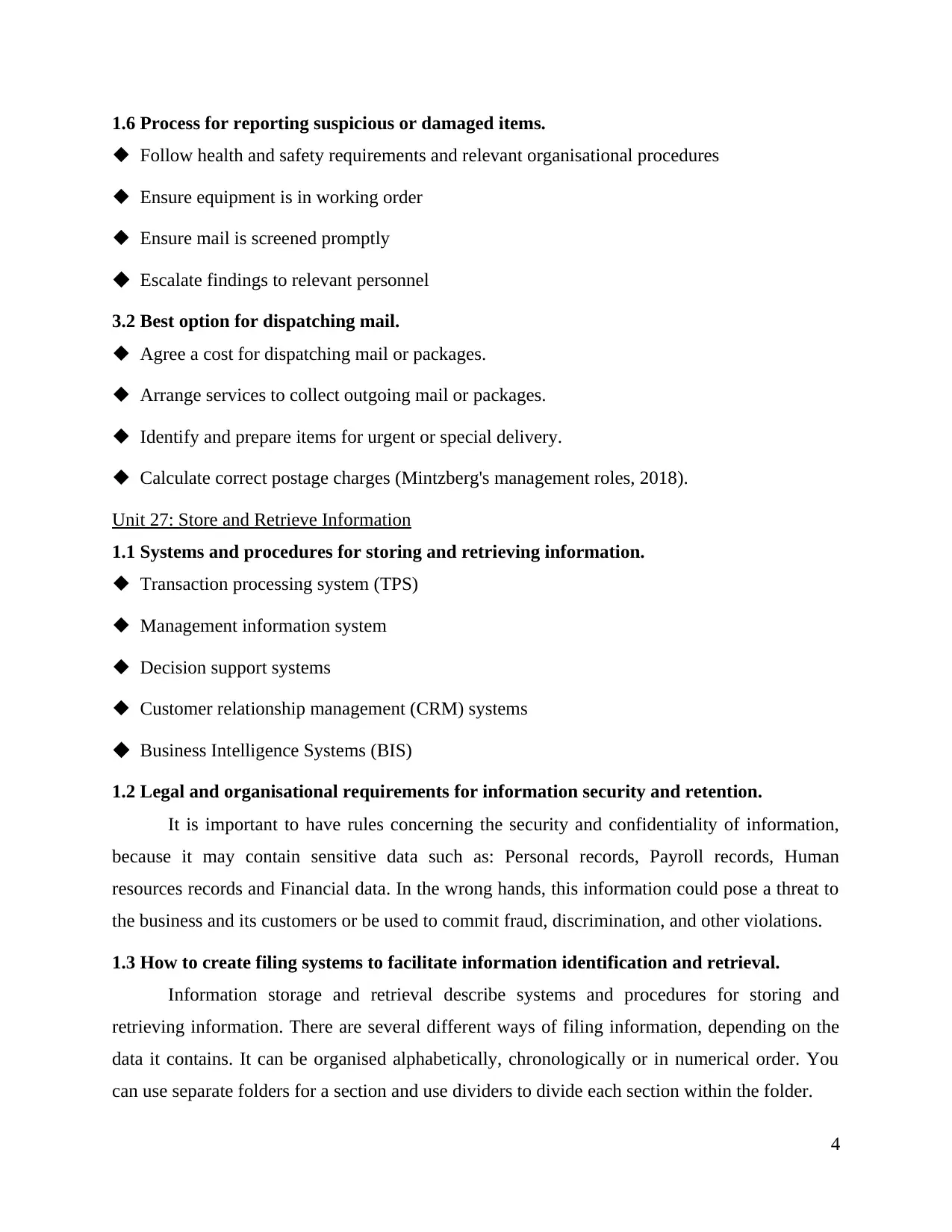
1.6 Process for reporting suspicious or damaged items.
Follow health and safety requirements and relevant organisational procedures
Ensure equipment is in working order
Ensure mail is screened promptly
Escalate findings to relevant personnel
3.2 Best option for dispatching mail.
Agree a cost for dispatching mail or packages.
Arrange services to collect outgoing mail or packages.
Identify and prepare items for urgent or special delivery.
Calculate correct postage charges (Mintzberg's management roles, 2018).
Unit 27: Store and Retrieve Information
1.1 Systems and procedures for storing and retrieving information.
Transaction processing system (TPS)
Management information system
Decision support systems
Customer relationship management (CRM) systems
Business Intelligence Systems (BIS)
1.2 Legal and organisational requirements for information security and retention.
It is important to have rules concerning the security and confidentiality of information,
because it may contain sensitive data such as: Personal records, Payroll records, Human
resources records and Financial data. In the wrong hands, this information could pose a threat to
the business and its customers or be used to commit fraud, discrimination, and other violations.
1.3 How to create filing systems to facilitate information identification and retrieval.
Information storage and retrieval describe systems and procedures for storing and
retrieving information. There are several different ways of filing information, depending on the
data it contains. It can be organised alphabetically, chronologically or in numerical order. You
can use separate folders for a section and use dividers to divide each section within the folder.
4
Follow health and safety requirements and relevant organisational procedures
Ensure equipment is in working order
Ensure mail is screened promptly
Escalate findings to relevant personnel
3.2 Best option for dispatching mail.
Agree a cost for dispatching mail or packages.
Arrange services to collect outgoing mail or packages.
Identify and prepare items for urgent or special delivery.
Calculate correct postage charges (Mintzberg's management roles, 2018).
Unit 27: Store and Retrieve Information
1.1 Systems and procedures for storing and retrieving information.
Transaction processing system (TPS)
Management information system
Decision support systems
Customer relationship management (CRM) systems
Business Intelligence Systems (BIS)
1.2 Legal and organisational requirements for information security and retention.
It is important to have rules concerning the security and confidentiality of information,
because it may contain sensitive data such as: Personal records, Payroll records, Human
resources records and Financial data. In the wrong hands, this information could pose a threat to
the business and its customers or be used to commit fraud, discrimination, and other violations.
1.3 How to create filing systems to facilitate information identification and retrieval.
Information storage and retrieval describe systems and procedures for storing and
retrieving information. There are several different ways of filing information, depending on the
data it contains. It can be organised alphabetically, chronologically or in numerical order. You
can use separate folders for a section and use dividers to divide each section within the folder.
4
⊘ This is a preview!⊘
Do you want full access?
Subscribe today to unlock all pages.

Trusted by 1+ million students worldwide
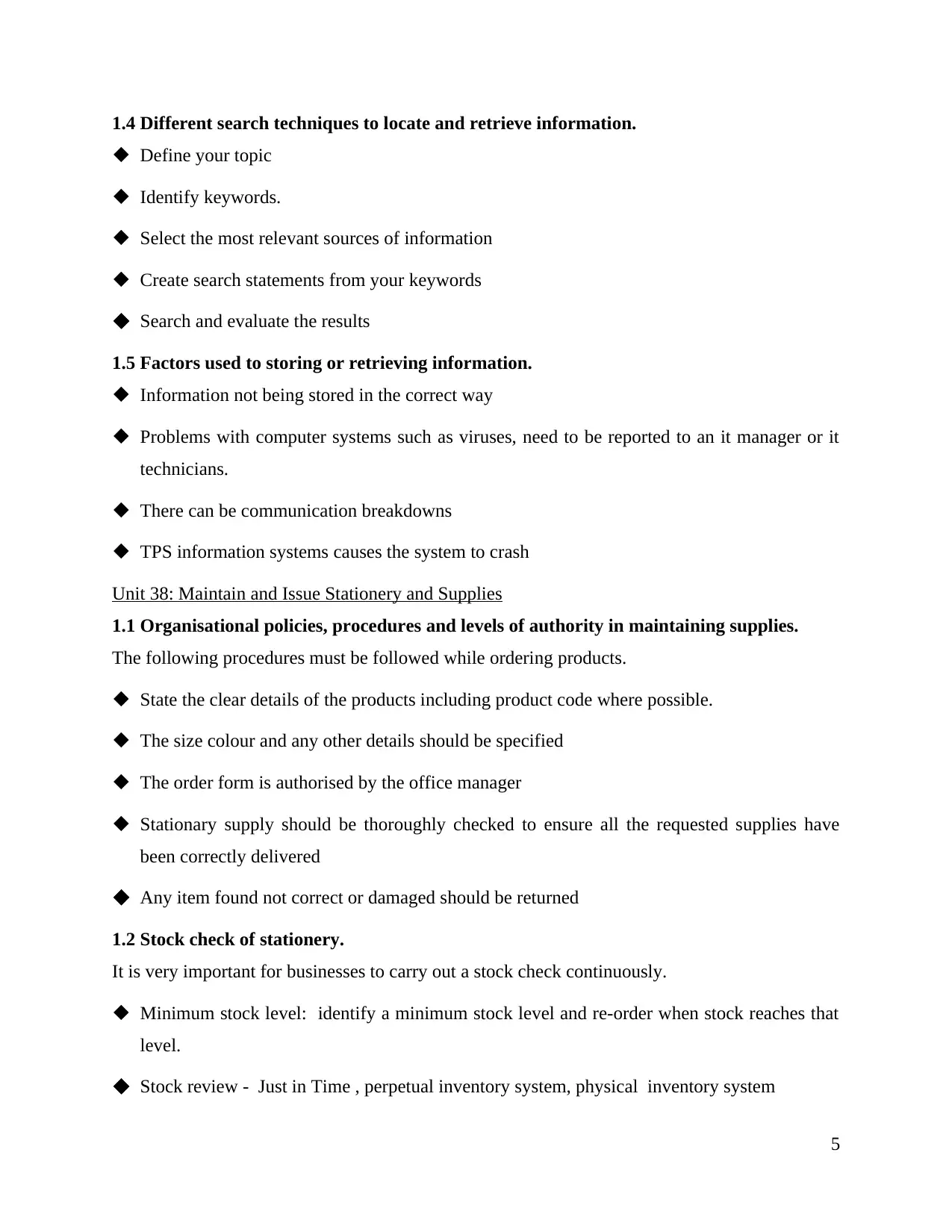
1.4 Different search techniques to locate and retrieve information.
Define your topic
Identify keywords.
Select the most relevant sources of information
Create search statements from your keywords
Search and evaluate the results
1.5 Factors used to storing or retrieving information.
Information not being stored in the correct way
Problems with computer systems such as viruses, need to be reported to an it manager or it
technicians.
There can be communication breakdowns
TPS information systems causes the system to crash
Unit 38: Maintain and Issue Stationery and Supplies
1.1 Organisational policies, procedures and levels of authority in maintaining supplies.
The following procedures must be followed while ordering products.
State the clear details of the products including product code where possible.
The size colour and any other details should be specified
The order form is authorised by the office manager
Stationary supply should be thoroughly checked to ensure all the requested supplies have
been correctly delivered
Any item found not correct or damaged should be returned
1.2 Stock check of stationery.
It is very important for businesses to carry out a stock check continuously.
Minimum stock level: identify a minimum stock level and re-order when stock reaches that
level.
Stock review - Just in Time , perpetual inventory system, physical inventory system
5
Define your topic
Identify keywords.
Select the most relevant sources of information
Create search statements from your keywords
Search and evaluate the results
1.5 Factors used to storing or retrieving information.
Information not being stored in the correct way
Problems with computer systems such as viruses, need to be reported to an it manager or it
technicians.
There can be communication breakdowns
TPS information systems causes the system to crash
Unit 38: Maintain and Issue Stationery and Supplies
1.1 Organisational policies, procedures and levels of authority in maintaining supplies.
The following procedures must be followed while ordering products.
State the clear details of the products including product code where possible.
The size colour and any other details should be specified
The order form is authorised by the office manager
Stationary supply should be thoroughly checked to ensure all the requested supplies have
been correctly delivered
Any item found not correct or damaged should be returned
1.2 Stock check of stationery.
It is very important for businesses to carry out a stock check continuously.
Minimum stock level: identify a minimum stock level and re-order when stock reaches that
level.
Stock review - Just in Time , perpetual inventory system, physical inventory system
5
Paraphrase This Document
Need a fresh take? Get an instant paraphrase of this document with our AI Paraphraser
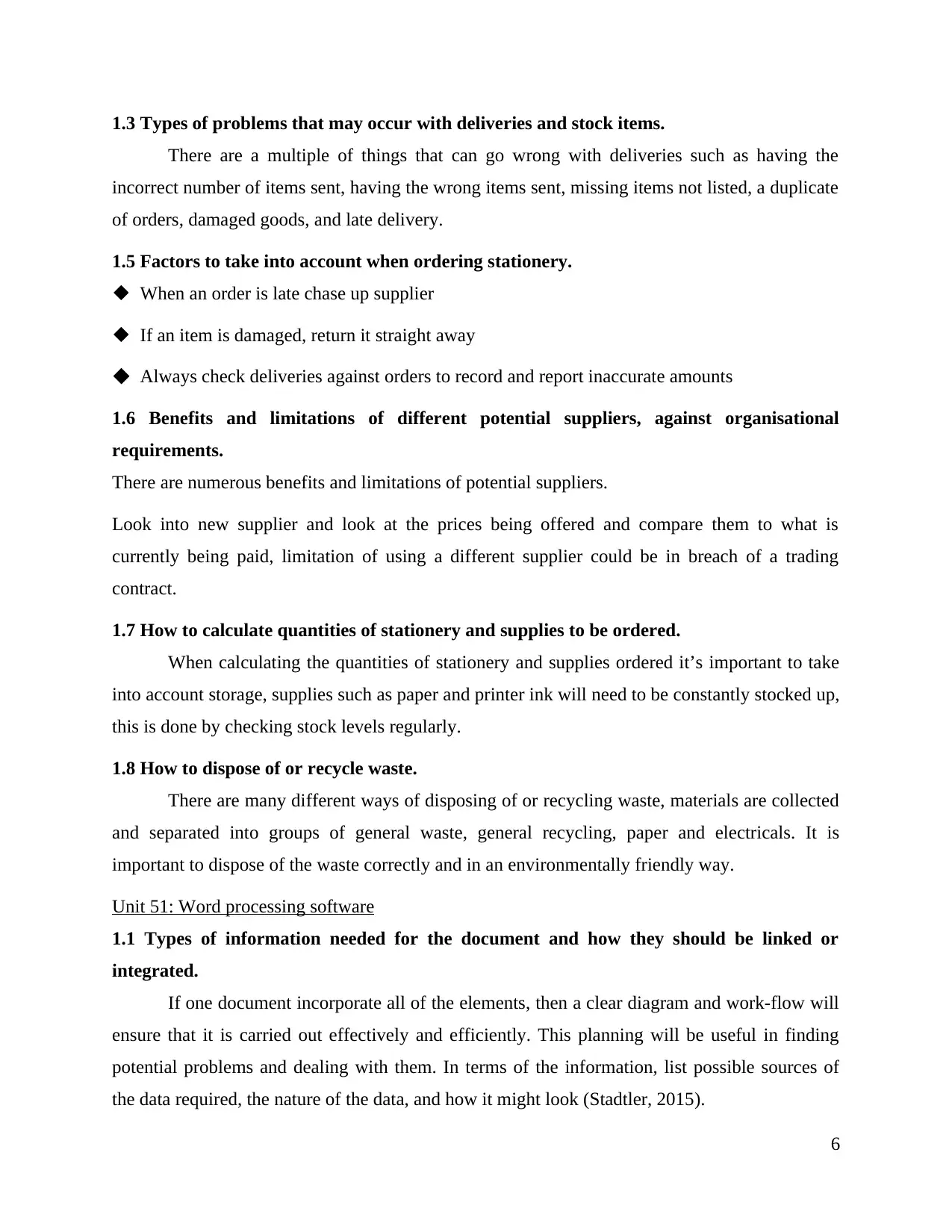
1.3 Types of problems that may occur with deliveries and stock items.
There are a multiple of things that can go wrong with deliveries such as having the
incorrect number of items sent, having the wrong items sent, missing items not listed, a duplicate
of orders, damaged goods, and late delivery.
1.5 Factors to take into account when ordering stationery.
When an order is late chase up supplier
If an item is damaged, return it straight away
Always check deliveries against orders to record and report inaccurate amounts
1.6 Benefits and limitations of different potential suppliers, against organisational
requirements.
There are numerous benefits and limitations of potential suppliers.
Look into new supplier and look at the prices being offered and compare them to what is
currently being paid, limitation of using a different supplier could be in breach of a trading
contract.
1.7 How to calculate quantities of stationery and supplies to be ordered.
When calculating the quantities of stationery and supplies ordered it’s important to take
into account storage, supplies such as paper and printer ink will need to be constantly stocked up,
this is done by checking stock levels regularly.
1.8 How to dispose of or recycle waste.
There are many different ways of disposing of or recycling waste, materials are collected
and separated into groups of general waste, general recycling, paper and electricals. It is
important to dispose of the waste correctly and in an environmentally friendly way.
Unit 51: Word processing software
1.1 Types of information needed for the document and how they should be linked or
integrated.
If one document incorporate all of the elements, then a clear diagram and work-flow will
ensure that it is carried out effectively and efficiently. This planning will be useful in finding
potential problems and dealing with them. In terms of the information, list possible sources of
the data required, the nature of the data, and how it might look (Stadtler, 2015).
6
There are a multiple of things that can go wrong with deliveries such as having the
incorrect number of items sent, having the wrong items sent, missing items not listed, a duplicate
of orders, damaged goods, and late delivery.
1.5 Factors to take into account when ordering stationery.
When an order is late chase up supplier
If an item is damaged, return it straight away
Always check deliveries against orders to record and report inaccurate amounts
1.6 Benefits and limitations of different potential suppliers, against organisational
requirements.
There are numerous benefits and limitations of potential suppliers.
Look into new supplier and look at the prices being offered and compare them to what is
currently being paid, limitation of using a different supplier could be in breach of a trading
contract.
1.7 How to calculate quantities of stationery and supplies to be ordered.
When calculating the quantities of stationery and supplies ordered it’s important to take
into account storage, supplies such as paper and printer ink will need to be constantly stocked up,
this is done by checking stock levels regularly.
1.8 How to dispose of or recycle waste.
There are many different ways of disposing of or recycling waste, materials are collected
and separated into groups of general waste, general recycling, paper and electricals. It is
important to dispose of the waste correctly and in an environmentally friendly way.
Unit 51: Word processing software
1.1 Types of information needed for the document and how they should be linked or
integrated.
If one document incorporate all of the elements, then a clear diagram and work-flow will
ensure that it is carried out effectively and efficiently. This planning will be useful in finding
potential problems and dealing with them. In terms of the information, list possible sources of
the data required, the nature of the data, and how it might look (Stadtler, 2015).
6
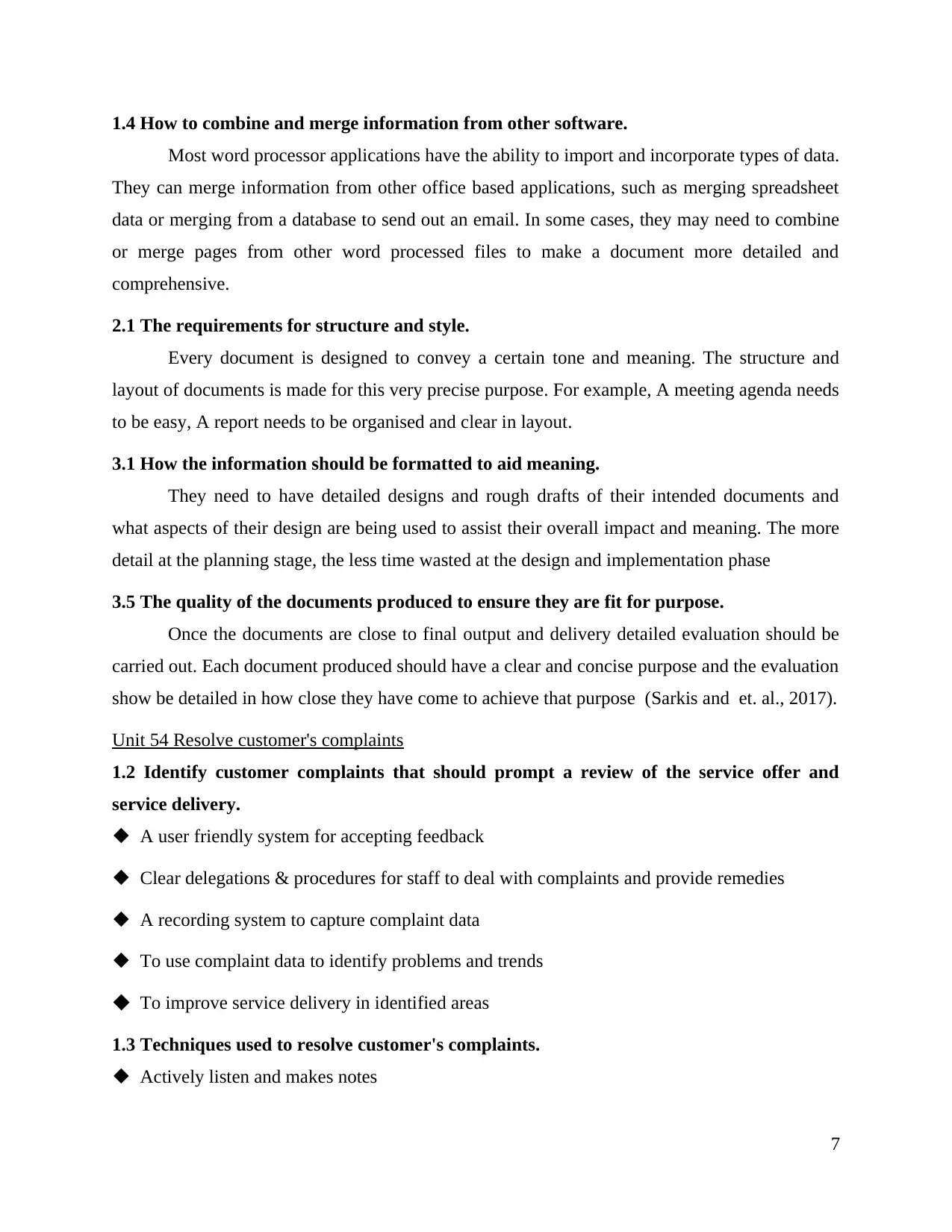
1.4 How to combine and merge information from other software.
Most word processor applications have the ability to import and incorporate types of data.
They can merge information from other office based applications, such as merging spreadsheet
data or merging from a database to send out an email. In some cases, they may need to combine
or merge pages from other word processed files to make a document more detailed and
comprehensive.
2.1 The requirements for structure and style.
Every document is designed to convey a certain tone and meaning. The structure and
layout of documents is made for this very precise purpose. For example, A meeting agenda needs
to be easy, A report needs to be organised and clear in layout.
3.1 How the information should be formatted to aid meaning.
They need to have detailed designs and rough drafts of their intended documents and
what aspects of their design are being used to assist their overall impact and meaning. The more
detail at the planning stage, the less time wasted at the design and implementation phase
3.5 The quality of the documents produced to ensure they are fit for purpose.
Once the documents are close to final output and delivery detailed evaluation should be
carried out. Each document produced should have a clear and concise purpose and the evaluation
show be detailed in how close they have come to achieve that purpose (Sarkis and et. al., 2017).
Unit 54 Resolve customer's complaints
1.2 Identify customer complaints that should prompt a review of the service offer and
service delivery.
A user friendly system for accepting feedback
Clear delegations & procedures for staff to deal with complaints and provide remedies
A recording system to capture complaint data
To use complaint data to identify problems and trends
To improve service delivery in identified areas
1.3 Techniques used to resolve customer's complaints.
Actively listen and makes notes
7
Most word processor applications have the ability to import and incorporate types of data.
They can merge information from other office based applications, such as merging spreadsheet
data or merging from a database to send out an email. In some cases, they may need to combine
or merge pages from other word processed files to make a document more detailed and
comprehensive.
2.1 The requirements for structure and style.
Every document is designed to convey a certain tone and meaning. The structure and
layout of documents is made for this very precise purpose. For example, A meeting agenda needs
to be easy, A report needs to be organised and clear in layout.
3.1 How the information should be formatted to aid meaning.
They need to have detailed designs and rough drafts of their intended documents and
what aspects of their design are being used to assist their overall impact and meaning. The more
detail at the planning stage, the less time wasted at the design and implementation phase
3.5 The quality of the documents produced to ensure they are fit for purpose.
Once the documents are close to final output and delivery detailed evaluation should be
carried out. Each document produced should have a clear and concise purpose and the evaluation
show be detailed in how close they have come to achieve that purpose (Sarkis and et. al., 2017).
Unit 54 Resolve customer's complaints
1.2 Identify customer complaints that should prompt a review of the service offer and
service delivery.
A user friendly system for accepting feedback
Clear delegations & procedures for staff to deal with complaints and provide remedies
A recording system to capture complaint data
To use complaint data to identify problems and trends
To improve service delivery in identified areas
1.3 Techniques used to resolve customer's complaints.
Actively listen and makes notes
7
⊘ This is a preview!⊘
Do you want full access?
Subscribe today to unlock all pages.

Trusted by 1+ million students worldwide
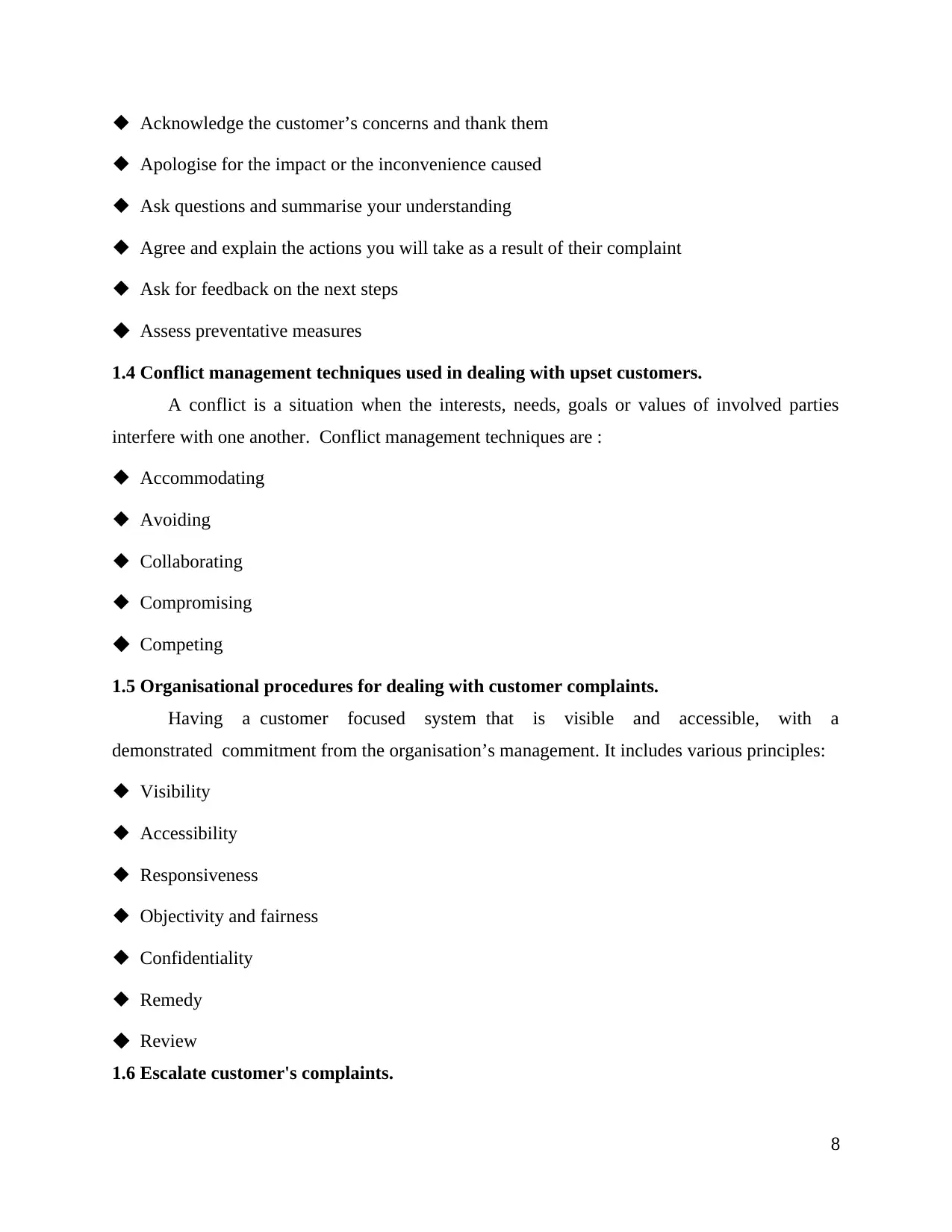
Acknowledge the customer’s concerns and thank them
Apologise for the impact or the inconvenience caused
Ask questions and summarise your understanding
Agree and explain the actions you will take as a result of their complaint
Ask for feedback on the next steps
Assess preventative measures
1.4 Conflict management techniques used in dealing with upset customers.
A conflict is a situation when the interests, needs, goals or values of involved parties
interfere with one another. Conflict management techniques are :
Accommodating
Avoiding
Collaborating
Compromising
Competing
1.5 Organisational procedures for dealing with customer complaints.
Having a customer focused system that is visible and accessible, with a
demonstrated commitment from the organisation’s management. It includes various principles:
Visibility
Accessibility
Responsiveness
Objectivity and fairness
Confidentiality
Remedy
Review
1.6 Escalate customer's complaints.
8
Apologise for the impact or the inconvenience caused
Ask questions and summarise your understanding
Agree and explain the actions you will take as a result of their complaint
Ask for feedback on the next steps
Assess preventative measures
1.4 Conflict management techniques used in dealing with upset customers.
A conflict is a situation when the interests, needs, goals or values of involved parties
interfere with one another. Conflict management techniques are :
Accommodating
Avoiding
Collaborating
Compromising
Competing
1.5 Organisational procedures for dealing with customer complaints.
Having a customer focused system that is visible and accessible, with a
demonstrated commitment from the organisation’s management. It includes various principles:
Visibility
Accessibility
Responsiveness
Objectivity and fairness
Confidentiality
Remedy
Review
1.6 Escalate customer's complaints.
8
Paraphrase This Document
Need a fresh take? Get an instant paraphrase of this document with our AI Paraphraser
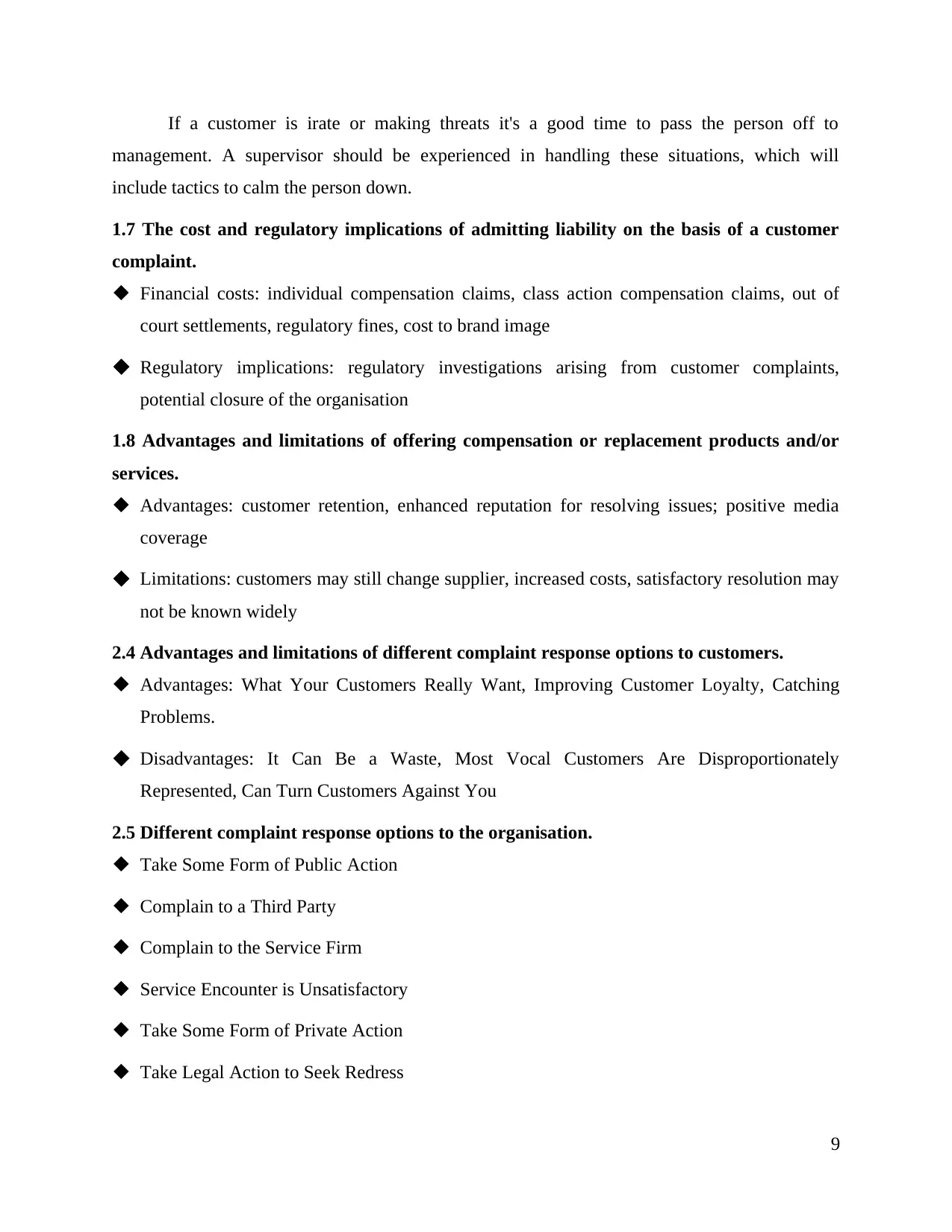
If a customer is irate or making threats it's a good time to pass the person off to
management. A supervisor should be experienced in handling these situations, which will
include tactics to calm the person down.
1.7 The cost and regulatory implications of admitting liability on the basis of a customer
complaint.
Financial costs: individual compensation claims, class action compensation claims, out of
court settlements, regulatory fines, cost to brand image
Regulatory implications: regulatory investigations arising from customer complaints,
potential closure of the organisation
1.8 Advantages and limitations of offering compensation or replacement products and/or
services.
Advantages: customer retention, enhanced reputation for resolving issues; positive media
coverage
Limitations: customers may still change supplier, increased costs, satisfactory resolution may
not be known widely
2.4 Advantages and limitations of different complaint response options to customers.
Advantages: What Your Customers Really Want, Improving Customer Loyalty, Catching
Problems.
Disadvantages: It Can Be a Waste, Most Vocal Customers Are Disproportionately
Represented, Can Turn Customers Against You
2.5 Different complaint response options to the organisation.
Take Some Form of Public Action
Complain to a Third Party
Complain to the Service Firm
Service Encounter is Unsatisfactory
Take Some Form of Private Action
Take Legal Action to Seek Redress
9
management. A supervisor should be experienced in handling these situations, which will
include tactics to calm the person down.
1.7 The cost and regulatory implications of admitting liability on the basis of a customer
complaint.
Financial costs: individual compensation claims, class action compensation claims, out of
court settlements, regulatory fines, cost to brand image
Regulatory implications: regulatory investigations arising from customer complaints,
potential closure of the organisation
1.8 Advantages and limitations of offering compensation or replacement products and/or
services.
Advantages: customer retention, enhanced reputation for resolving issues; positive media
coverage
Limitations: customers may still change supplier, increased costs, satisfactory resolution may
not be known widely
2.4 Advantages and limitations of different complaint response options to customers.
Advantages: What Your Customers Really Want, Improving Customer Loyalty, Catching
Problems.
Disadvantages: It Can Be a Waste, Most Vocal Customers Are Disproportionately
Represented, Can Turn Customers Against You
2.5 Different complaint response options to the organisation.
Take Some Form of Public Action
Complain to a Third Party
Complain to the Service Firm
Service Encounter is Unsatisfactory
Take Some Form of Private Action
Take Legal Action to Seek Redress
9
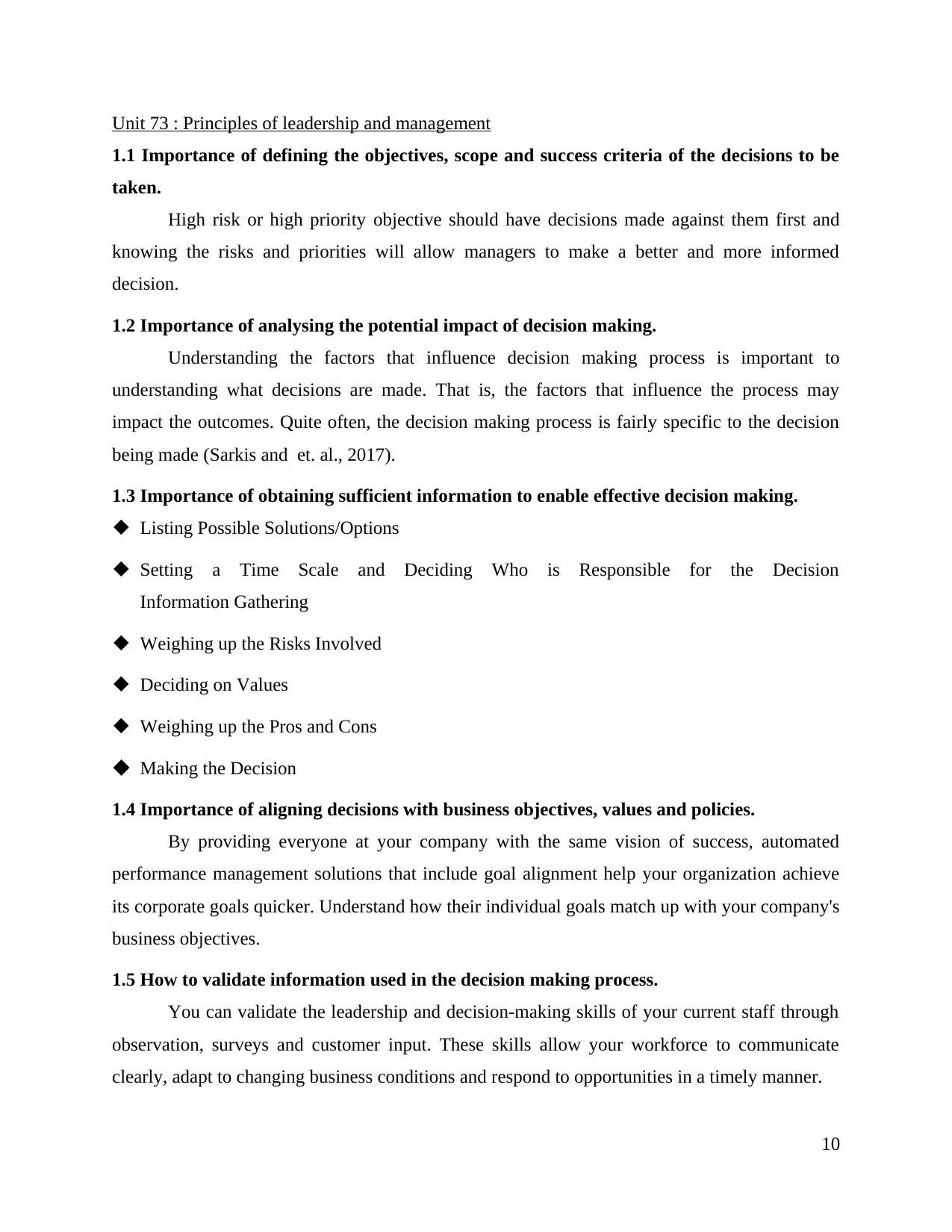
Unit 73 : Principles of leadership and management
1.1 Importance of defining the objectives, scope and success criteria of the decisions to be
taken.
High risk or high priority objective should have decisions made against them first and
knowing the risks and priorities will allow managers to make a better and more informed
decision.
1.2 Importance of analysing the potential impact of decision making.
Understanding the factors that influence decision making process is important to
understanding what decisions are made. That is, the factors that influence the process may
impact the outcomes. Quite often, the decision making process is fairly specific to the decision
being made (Sarkis and et. al., 2017).
1.3 Importance of obtaining sufficient information to enable effective decision making.
Listing Possible Solutions/Options
Setting a Time Scale and Deciding Who is Responsible for the Decision
Information Gathering
Weighing up the Risks Involved
Deciding on Values
Weighing up the Pros and Cons
Making the Decision
1.4 Importance of aligning decisions with business objectives, values and policies.
By providing everyone at your company with the same vision of success, automated
performance management solutions that include goal alignment help your organization achieve
its corporate goals quicker. Understand how their individual goals match up with your company's
business objectives.
1.5 How to validate information used in the decision making process.
You can validate the leadership and decision-making skills of your current staff through
observation, surveys and customer input. These skills allow your workforce to communicate
clearly, adapt to changing business conditions and respond to opportunities in a timely manner.
10
1.1 Importance of defining the objectives, scope and success criteria of the decisions to be
taken.
High risk or high priority objective should have decisions made against them first and
knowing the risks and priorities will allow managers to make a better and more informed
decision.
1.2 Importance of analysing the potential impact of decision making.
Understanding the factors that influence decision making process is important to
understanding what decisions are made. That is, the factors that influence the process may
impact the outcomes. Quite often, the decision making process is fairly specific to the decision
being made (Sarkis and et. al., 2017).
1.3 Importance of obtaining sufficient information to enable effective decision making.
Listing Possible Solutions/Options
Setting a Time Scale and Deciding Who is Responsible for the Decision
Information Gathering
Weighing up the Risks Involved
Deciding on Values
Weighing up the Pros and Cons
Making the Decision
1.4 Importance of aligning decisions with business objectives, values and policies.
By providing everyone at your company with the same vision of success, automated
performance management solutions that include goal alignment help your organization achieve
its corporate goals quicker. Understand how their individual goals match up with your company's
business objectives.
1.5 How to validate information used in the decision making process.
You can validate the leadership and decision-making skills of your current staff through
observation, surveys and customer input. These skills allow your workforce to communicate
clearly, adapt to changing business conditions and respond to opportunities in a timely manner.
10
⊘ This is a preview!⊘
Do you want full access?
Subscribe today to unlock all pages.

Trusted by 1+ million students worldwide
1 out of 16
Your All-in-One AI-Powered Toolkit for Academic Success.
+13062052269
info@desklib.com
Available 24*7 on WhatsApp / Email
![[object Object]](/_next/static/media/star-bottom.7253800d.svg)
Unlock your academic potential
Copyright © 2020–2025 A2Z Services. All Rights Reserved. Developed and managed by ZUCOL.
